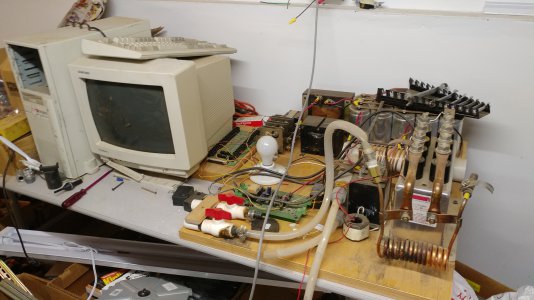- Joined
- Jan 1, 2018
- Messages
- 1,152
This was my senior project MANY years ago:

Converting 120v/240v single phase AC current into DC then outputting high current high frequency AC through a copper coil.
What made it unique is the 80286 DOS computer is controlling the firing of the IGBT's to generate the high frequency AC... then it measures the time between the peak of the output AC Current wave and the peak of the output Voltage wave then varies the base frequency by minor percentages to keep the peak of the voltage curve and the peak of the current curve as close as possible even when the load on the coil changes due to the mass and temperature of the part in the coil changing.
The closer the output current wave matches the output voltage wave the more the power that goes into the metallic part in the middle of the coil and the more efficiently the coil functions. When the voltage curve matches the current curve very close the area under the curve is the actual power that goes into the part and can be calculated. When the voltage wave and current wave are not in sync the power actually going into the part can only be approximated. The initial temperature of the part, the actual power going into the part and the time it takes to heat the part can be used to determine depth of the heating and predict if a part is properly heat treated.
Operating range was 15kHz to 30kHz with the power circuit and coil designed to reach max efficiency around 20kHz. I had to use an ADLink ISA A/D I/O timer board to interface the PC to the induction heater because I couldn't afford any of the expensive Allen Bradley boards. Software was written in Borland Turbo C. The water cooling hoses are not currently both connected up but the 2 IGBT's were water cooled and the coil was also water cooled. The coil did not in itself heat up, the radiant heat from the part is what heated up the coil. Yes, those are scorch marks on the coil where the varnish on the coil overheated by leaving a part in the coil too long (actually I think I forgot to open the water valve to cool the coil that one time). I only dealt with steel below its specific curry temperature. When the temperature of steel exceeds its curry temperature the induction characteristics of the steel change significantly.

Converting 120v/240v single phase AC current into DC then outputting high current high frequency AC through a copper coil.
What made it unique is the 80286 DOS computer is controlling the firing of the IGBT's to generate the high frequency AC... then it measures the time between the peak of the output AC Current wave and the peak of the output Voltage wave then varies the base frequency by minor percentages to keep the peak of the voltage curve and the peak of the current curve as close as possible even when the load on the coil changes due to the mass and temperature of the part in the coil changing.
The closer the output current wave matches the output voltage wave the more the power that goes into the metallic part in the middle of the coil and the more efficiently the coil functions. When the voltage curve matches the current curve very close the area under the curve is the actual power that goes into the part and can be calculated. When the voltage wave and current wave are not in sync the power actually going into the part can only be approximated. The initial temperature of the part, the actual power going into the part and the time it takes to heat the part can be used to determine depth of the heating and predict if a part is properly heat treated.
Operating range was 15kHz to 30kHz with the power circuit and coil designed to reach max efficiency around 20kHz. I had to use an ADLink ISA A/D I/O timer board to interface the PC to the induction heater because I couldn't afford any of the expensive Allen Bradley boards. Software was written in Borland Turbo C. The water cooling hoses are not currently both connected up but the 2 IGBT's were water cooled and the coil was also water cooled. The coil did not in itself heat up, the radiant heat from the part is what heated up the coil. Yes, those are scorch marks on the coil where the varnish on the coil overheated by leaving a part in the coil too long (actually I think I forgot to open the water valve to cool the coil that one time). I only dealt with steel below its specific curry temperature. When the temperature of steel exceeds its curry temperature the induction characteristics of the steel change significantly.
Last edited:

